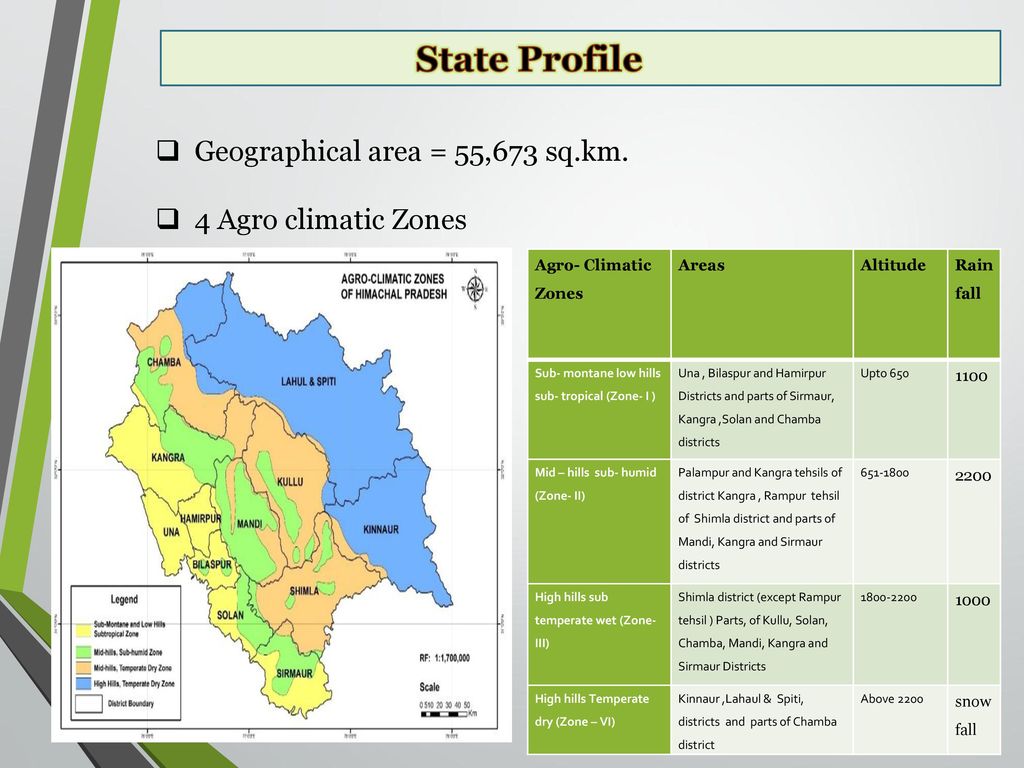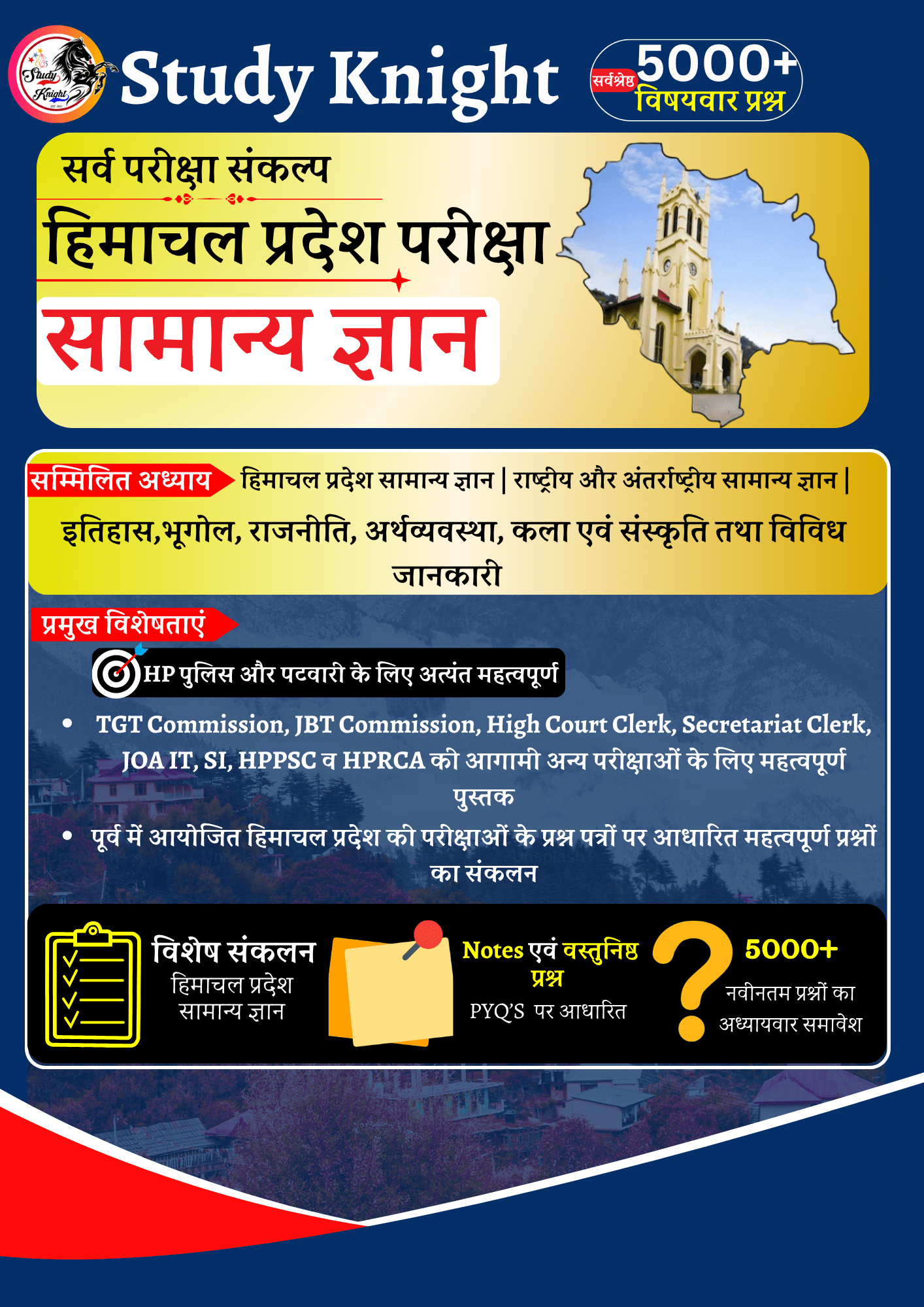Agro Climatic Zones of Himachal Pradesh
Himachal Pradesh, due to its diverse topography and elevation, is divided into several agro-climatic zones, each with its own specific climate and suitability for different types of agriculture. Here’s a brief overview:

- Sub-Tropical Zone:
- Altitude: 300-700 meters.
- Climate: Hot summers and mild winters.
- Crops: Ideal for crops like rice, maize, and various fruits such as citrus fruits and guava.
- Sub-Montane Zone:
- Altitude: 700-1,200 meters.
- Climate: Moderate temperatures with distinct seasons.
- Crops: Suitable for crops like wheat, barley, and temperate fruits such as apples and pears.
- Montane Zone:
- Altitude: 1,200-2,200 meters.
- Climate: Cooler temperatures with heavy rainfall during the monsoon season.
- Crops: Favorable for high-value crops like potatoes, pulses, and various vegetables, along with apples and plums.
- High Montane Zone:
- Altitude: Above 2,200 meters.
- Climate: Cold with heavy snowfall in winter and cool summers.
- Crops: Limited to hardy crops such as barley, oats, and certain vegetables; also used for grazing livestock.
These zones help in planning agricultural activities and choosing appropriate crops based on local climate and altitude conditions.
हिमाचल प्रदेश के कृषि जलवायु क्षेत्र


- शिवालिक पहाड़ी क्षेत्र:
- जलवायु: उपोष्णकटिबंधीय
- ऊँचाई: समुद्र तल से 350 से 650 मीटर
- भौगोलिक क्षेत्र: राज्य के कुल भौगोलिक क्षेत्र का लगभग 35% और कृषि योग्य क्षेत्र का लगभग 40%
- प्रमुख फसलें: गेहूं, मक्का, धान, चना, गन्ना, सरसों, आलू, सब्जियाँ
- विशेषताएँ: इस क्षेत्र में उगाई जाने वाली फसलों की विविधता और उपज की संभावनाएँ व्यापक हैं।
- मध्य-पहाड़ी क्षेत्र:
- जलवायु: हल्की शीतोष्ण
- ऊँचाई: समुद्र तल से 651 मीटर से 1,800 मीटर
- भौगोलिक क्षेत्र: राज्य के कुल भौगोलिक क्षेत्र का लगभग 32% और कृषि योग्य क्षेत्र का लगभग 37%
- प्रमुख फसलें: गेहूं, मक्का, जौ, उड़द, सेम, धान
- विशेषताएँ: नकदी फसलों जैसे बेमौसमी सब्जियाँ, अदरक की खेती, और शीतोष्ण सब्जियाँ जैसे फूलगोभी और जड़ वाली फसलों के बीजों के उत्पादन के लिए उपयुक्त।
- उच्च पहाड़ी क्षेत्र:
- जलवायु: आर्द्र शीतोष्ण, अल्पाइन चरागाह
- ऊँचाई: समुद्र तल से 1,801 से 2,200 मीटर
- भौगोलिक क्षेत्र: राज्य के भौगोलिक क्षेत्र का लगभग 35% और कृषि योग्य क्षेत्र का लगभग 21%
- प्रमुख फसलें: गेहूं, जौ, बाजरा, छद्म अनाज (बकव्हीट और ऐमारैंथस), मक्का, आलू
- विशेषताएँ: गुणवत्तायुक्त आलू बीज और शीतोष्ण सब्जियों के उत्पादन के लिए आदर्श। अच्छे चारागाह और घास के मैदान भी हैं।
- ठंडा शुष्क क्षेत्र:
- जलवायु: ठंडा शुष्क
- ऊँचाई: समुद्र तल से लगभग 2,200 मीटर
- भौगोलिक क्षेत्र: राज्य के भौगोलिक क्षेत्र का लगभग 8% और कुल कृषि योग्य क्षेत्र का 2%
- प्रमुख फसलें: गेहूं, जौ, छद्म अनाज (बक गेहूं और ऐमारैंथस)
- विशेषताएँ: गुणवत्तायुक्त बीज आलू, शीतोष्ण और यूरोपीय प्रकार की सब्जियाँ, और हरे और बीज प्रयोजनों के लिए उपयुक्त।
इन जलवायु क्षेत्रों की विशेषताओं के आधार पर, हिमाचल प्रदेश में विभिन्न प्रकार की फसलों का उत्पादन किया जाता है और कृषि गतिविधियाँ भिन्न-भिन्न जलवायु और ऊँचाई के अनुसार अनुकूलित की जाती हैं।
The agro-climatic zones of Himachal Pradesh reflect the state’s varied altitude, temperature, and climatic conditions, which significantly influence its agricultural practices. Here’s a summary of each zone’s characteristics:
1. Shivalik Zone (Low Hills)
- Altitude: 350-650 meters above sea level
- Climate: Sub-tropical
- Crops: This zone supports a diverse range of crops such as wheat, maize, rice, sugarcane, oilseeds, and vegetables. The favorable climatic conditions and fertile plains contribute to its suitability for both food and cash crops.
- Challenges: Soil erosion and waterlogging can be issues in some areas.
2. Mid-Hill Zone
- Altitude: 651-1800 meters above sea level
- Climate: Mild temperate
- Crops: The zone is known for cultivating wheat, maize, barley, pulses, and oilseeds. It has also become prominent in horticulture, with apples, pears, and peaches as major cash crops.
- Challenges: Fragmented landholdings, challenging hilly terrain, and susceptibility to frost are key difficulties.
3. High Hill Zone
- Altitude: 1801-2200 meters above sea level
- Climate: Temperate to cold
- Crops: The main crops include wheat, barley, and potatoes. However, due to the harsher climatic conditions, agricultural productivity is relatively lower.
- Challenges: Short growing season, low temperatures, and less fertile soils limit agricultural output.
4. Cold Desert Zone
- Altitude: Above 2200 meters above sea level
- Climate: Cold and arid
- Crops: This zone is primarily used for livestock rearing due to its harsh conditions. Hardy crops like barley and potatoes are cultivated in select areas where conditions permit.
- Challenges: Extremely low temperatures, minimal rainfall, and a very short growing season pose significant constraints to agriculture.
Each of these zones requires tailored agricultural strategies to address their unique climatic and soil conditions, optimizing productivity and sustainability.
Factors Influencing Agro-Climatic Zones
Several factors contribute to the differentiation of these agro-climatic zones:
- Topography: The mountainous terrain of Himachal Pradesh creates diverse microclimates, influencing temperature, rainfall, and soil conditions.
- Altitude: As altitude increases, temperature decreases, affecting crop suitability and cultivation practices.
- Slope: The steep slopes in many parts of the state limit agricultural land availability and increase the risk of soil erosion.
- Soil Type: The variation in soil types across the state influences crop productivity and suitability.
- Rainfall: The distribution and amount of rainfall determine the cropping pattern and irrigation requirements.
Adaptation and Challenges
Farmers in Himachal Pradesh have adapted their farming practices to suit the specific conditions of their agro-climatic zone. However, they face numerous challenges such as:
- Fragmented landholdings: Small and scattered landholdings hinder mechanization and efficient farming.
- Soil erosion: The hilly terrain is prone to soil erosion, leading to loss of fertility.
- Limited irrigation facilities: Dependence on rainfall for irrigation can be risky, especially during droughts.
- Climate change: Changing weather patterns pose a threat to crop production and livelihoods.
Opportunities for Development
Despite the challenges, Himachal Pradesh offers significant opportunities for agricultural development:
- Horticulture: The state’s favorable climate and terrain are ideal for horticulture, with apples, peaches, and grapes being major cash crops.
- Organic farming: The region’s pristine environment provides a suitable setting for organic agriculture, catering to the growing demand for organic products.
- Livestock rearing: The cold desert region can be developed as a hub for livestock rearing, focusing on high-value breeds.
- Agro-tourism: Combining agriculture with tourism can generate additional income for farmers.
By addressing the challenges and leveraging its strengths, Himachal Pradesh can achieve sustainable agricultural growth and improve the livelihoods of its rural population.
Ecological zones of Himachal Pradesh:
| Zone | Area (Sq km [%]) | Elevation (M) | Mean Annual Temperature [°C] | Soil Type | Rainfall (mm) | Important Crops |
|---|---|---|---|---|---|---|
| Sub-Tropical Sub-Montane & Low Hills | ||||||
| Zone 1.1 | 8201 [14.73%] | 240-1000 | 15 to 23 | Sandy loams (Light Textured, Shallow) | ≤1500 | Wheat, Maize, Paddy, Pulses, Oilseeds, Barley, Sugarcane, Potato, Watermelon & Vegetables |
| Zone 1.2 | 2059 [3.70%] | 240-1000 | 18.6 – 21.9 | Loamy sand (medium in depth) | >1500 | Wheat, Paddy, Maize, Seed Potato, Pulses, Oilseeds |
| Sub-Humid Mid Hills | ||||||
| Zone 2.1 | 3770 [6.77%] | 1001-1500 | 14.2 – 22.1 | Sandy Loam- Clay loam (Acidic) | ≤1500 | Wheat, Paddy, Barley, Pulses, Oilseeds, Off-Season Vegetables |
| Zone 2.2 | 894 [1.60%] | 1001-1500 | 16.53 – 21.25 | Silt Loam- Loam | >1500 | Wheat, Paddy, Barley, Pulses, Oilseeds, Off-Season Vegetables in some parts |
| Wet Temperate High Hills | ||||||
| Zone 3.1 | 8207 [14.74%] | 1501-2500 | 9.1 – 20.6 | Mainly Loamy shallow, acidic | ≤1500 | Wheat, Barley, Maize, Millets, Pulses, Oilseeds, Temperate Vegetables, Apple, and Off-Season Vegetables |
| Zone 3.2 | 1010 [1.81%] | 1501-3250 | 15.4 – 20.5 | Sandy Loams shallow to Medium depth | >1500 | Maize, Wheat, Pulses, Oilseeds |
| Dry Temperate High Hills | ||||||
| Zone 4.1 | 4616 [8.29%] | 2501-3250 | 9 – 20 | Sandy Loams (Shallow in depth) | <700 (Dry) | Wheat, Potato, Barley, Buckwheat, Peas, Minor Millets, Kuth & Temperate Vegetables, Hops, Cumin, & Saffron, Apple, and Dry Fruits |
| Zone 4.2 | 7003 [12.58%] | 3251-4250 | 8.8 – 19.9 | Sandy Loams (Shallow) | Dry/Snow | Quality Seed Potato, Temperate & European Type Vegetables, Barley, Buckwheat, and Wheat |
| Zone 4.3 | 19890 [35.74%] | >4250 | 8.7-19.7 | Sands & Pebbles (Loose Textured) | Dry/Snow | Buckwheat, Barley, Minor Millets, Kala Zeera, and Wheat |
This table is designed to be easily readable and includes key details about each agro-ecological zone.
Q.1
Which zone in Himachal Pradesh has an elevation range of 240-1000 meters?
A. Sub-Humid Mid Hills
B. Dry Temperate High Hills
C. Wet Temperate High Hills
D. Sub-Tropical Sub-Montane & Low Hills
Answer: D. Sub-Tropical Sub-Montane & Low Hills
Explanation: Zones 1.1 and 1.2 in the Sub-Tropical Sub-Montane & Low Hills range from 240-1000 meters in elevation.
Q.2
What is the primary crop grown in Zone 4.3 of Himachal Pradesh?
A. Maize
B. Buckwheat
C. Apples
D. Rice
Answer: B. Buckwheat
Explanation: Zone 4.3 is known for growing Buckwheat, along with Barley, Minor Millets, and Kala Zeera.
Q.3
Which soil type is found in Zone 2.1 of Himachal Pradesh?
A. Loamy sand
B. Sandy Loam- Clay loam (Acidic)
C. Sandy loams (Shallow)
D. Sandy Loams (Medium depth)
Answer: B. Sandy Loam- Clay loam (Acidic)
Explanation: Zone 2.1 features Sandy Loam- Clay loam (Acidic) soil type.
Q.4
In which zone is the mean annual temperature range 16.53 – 21.25°C?
A. Zone 2.2
B. Zone 3.1
C. Zone 4.2
D. Zone 1.2
Answer: A. Zone 2.2
Explanation: Zone 2.2 has a mean annual temperature range of 16.53 – 21.25°C.
Q.5
What is the elevation range of Zone 3.2?
A. 1001-1500 meters
B. 1501-2500 meters
C. 2501-3250 meters
D. Above 4250 meters
Answer: B. 1501-3250 meters
Explanation: Zone 3.2 is located at elevations between 1501 and 3250 meters.
Q.6
Which crop is typically grown in Zone 1.1 with sandy loams soil?
A. Apples
B. Barley
C. Sugarcane
D. Hops
Answer: C. Sugarcane
Explanation: Zone 1.1, characterized by sandy loams, supports crops such as sugarcane.
Q.7
Which zone has the highest mean annual temperature range of 18.6 – 21.9°C?
A. Zone 1.1
B. Zone 2.1
C. Zone 1.2
D. Zone 3.1
Answer: C. Zone 1.2
Explanation: Zone 1.2 experiences a mean annual temperature range of 18.6 – 21.9°C.
Q.8
Which soil type is predominant in Zone 4.1?
A. Sandy Loams (Shallow in depth)
B. Loamy sand
C. Silt Loam
D. Sandy Loams (Shallow)
Answer: A. Sandy Loams (Shallow in depth)
Explanation: Zone 4.1 is characterized by Sandy Loams (Shallow in depth).
Q.9
What is the main crop in Zone 2.2 where the soil is Silt Loam- Loam?
A. Potatoes
B. Rice
C. Off-season Vegetables
D. Hops
Answer: C. Off-season Vegetables
Explanation: Zone 2.2, with Silt Loam- Loam soil, is known for growing off-season vegetables.
Q.10
Which zone is characterized by a mean annual temperature of 8.7 – 19.7°C?
A. Zone 4.2
B. Zone 4.3
C. Zone 3.2
D. Zone 2.1
Answer: B. Zone 4.3
Explanation: Zone 4.3 has a mean annual temperature range of 8.7 – 19.7°C.
Q.11
In which zone is the rainfall typically less than 700 mm?
A. Zone 1.1
B. Zone 2.1
C. Zone 4.1
D. Zone 3.1
Answer: C. Zone 4.1
Explanation: Zone 4.1 experiences less than 700 mm of rainfall, indicating a dry climate.
Q.12
Which zone is located at an elevation of 3251-4250 meters?
A. Zone 4.1
B. Zone 4.2
C. Zone 2.2
D. Zone 1.2
Answer: B. Zone 4.2
Explanation: Zone 4.2 has an elevation range of 3251-4250 meters.
Q.13
What is the primary crop in Zone 3.1?
A. Sugarcane
B. Rice
C. Apple
D. Millet
Answer: C. Apple
Explanation: Zone 3.1 is known for growing apples among other crops.
Q.14
Which zone has the soil type “Mainly Loamy shallow, acidic”?
A. Zone 4.3
B. Zone 2.1
C. Zone 3.1
D. Zone 1.2
Answer: C. Zone 3.1
Explanation: Zone 3.1 features Mainly Loamy shallow, acidic soil.
Q.15
What type of soil is found in Zone 2.1?
A. Sandy Loam- Clay loam (Acidic)
B. Loamy sand
C. Sandy loams (Medium depth)
D. Sandy Loams (Shallow)
Answer: A. Sandy Loam- Clay loam (Acidic)
Explanation: Zone 2.1 has Sandy Loam- Clay loam (Acidic) soil.
Q.16
Which zone is characterized by “Sands & Pebbles (Loose Textured)” soil?
A. Zone 4.1
B. Zone 3.2
C. Zone 4.2
D. Zone 4.3
Answer: D. Zone 4.3
Explanation: Zone 4.3 has Sands & Pebbles (Loose Textured) soil.
Q.17
In which zone is the rainfall typically more than 1500 mm?
A. Zone 2.2
B. Zone 3.2
C. Zone 4.1
D. Zone 1.2
Answer: A. Zone 2.2
Explanation: Zone 2.2 receives more than 1500 mm of rainfall.
Q.18
What is the mean annual temperature range in Zone 4.2?
A. 8.7 – 19.7°C
B. 9.1 – 20.6°C
C. 15.4 – 20.5°C
D. 8.8 – 19.9°C
Answer: D. 8.8 – 19.9°C
Explanation: Zone 4.2 has a mean annual temperature range of 8.8 – 19.9°C.
Q.19
Which crop is primarily grown in Zone 4.2?
A. Off-season Vegetables
B. Quality Seed Potato
C. Maize
D. Barley
Answer: B. Quality Seed Potato
Explanation: Zone 4.2 is known for producing Quality Seed Potato.
Q.20
What is the primary characteristic of the soil in Zone 1.2?
A. Loamy sand (medium in depth)
B. Sandy loams (Light Textured, Shallow)
C. Sandy Loams (Shallow)
D. Sandy Loams (Medium depth)
Answer: A. Loamy sand (medium in depth)
Explanation: Zone 1.2 has Loamy sand (medium in depth) as its primary soil type.
These questions cover various aspects of the agro-ecological zones, including soil types, temperature ranges, crop types, and more.
1. Which agro-climatic zone of Himachal Pradesh is known for high rainfall and diverse vegetation?
Answer: Wet Temperate High Hills.
2. What is the main challenge for agriculture in the Sub-Humid Mid Hills zone?
Answer: Soil erosion and high rainfall variability.
3. Which zone is characterized by sandy loams with a shallow depth?
Answer: Dry Temperate High Hills.
4. In which zone is off-season vegetable cultivation especially prominent?
Answer: Sub-Humid Mid Hills.
5. What is the primary soil type found in the Cold Desert Zone?
Answer: Sands and pebbles.
6. Which agro-climatic zone has a significant area with dry or snowy conditions?
Answer: Dry Temperate High Hills.
7. What is a key feature of the soil in the Wet Temperate High Hills zone?
Answer: Mainly loamy and shallow with acidic properties.
8. Which zone supports the cultivation of crops like buckwheat and minor millets?
Answer: Dry Temperate High Hills.
9. What type of vegetation is most common in the Cold Desert Zone?
Answer: Hardy and drought-resistant plants.
10. Which agro-climatic zone has the highest altitude range?
Answer: Cold Desert Area.
11. What type of climate is experienced in the Sub-Tropical Sub Montane zone?
Answer: Sub-tropical with moderate temperatures.
12. Which zone is known for its deep and fertile loamy soils ideal for diverse crops?
Answer: Wet Temperate High Hills.
13. What kind of crops are suited for the loamy sand soils in the Sub-Tropical Sub Montane zone?
Answer: Wheat, maize, and paddy.
14. Which zone is specifically known for having sandy loams with shallow depth?
Answer: Dry Temperate High Hills.
15. What major challenge is associated with farming in the Cold Desert Area?
Answer: Severe cold and limited water resources.
16. Which zone is particularly prone to waterlogging issues due to its high rainfall?
Answer: Wet Temperate High Hills.
17. What type of crops are generally avoided in the Cold Desert Zone due to climatic conditions?
Answer: Rice and other water-intensive crops.
18. In which zone is potato production a significant agricultural activity?
Answer: High-Hilly Region and Cold Desert Area.
19. Which zone has the lowest annual rainfall among the agro-climatic zones?
Answer: Dry Temperate High Hills.
20. What is a typical economic activity in the Sub-Humid Mid Hills apart from crop cultivation?
Answer: Horticulture and vegetable farming.











